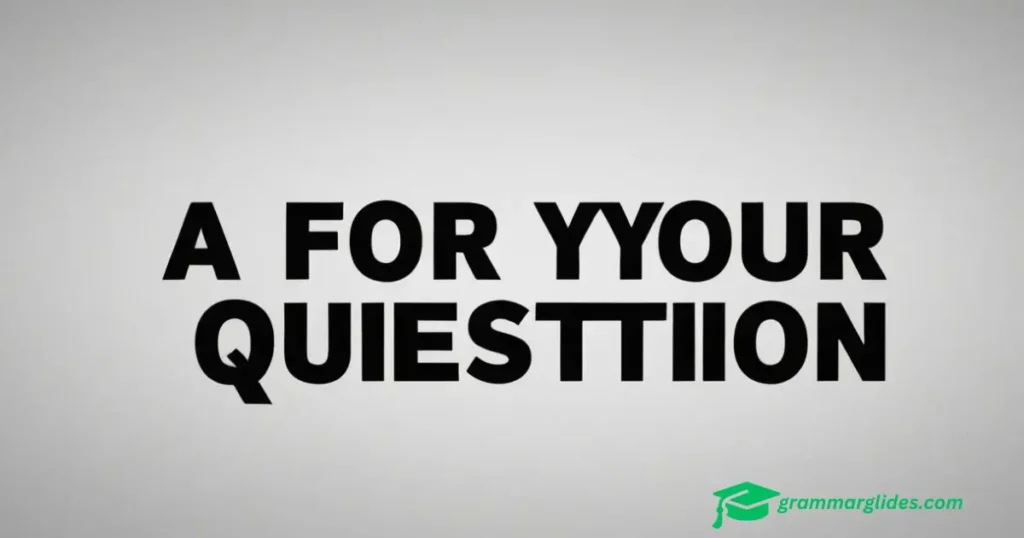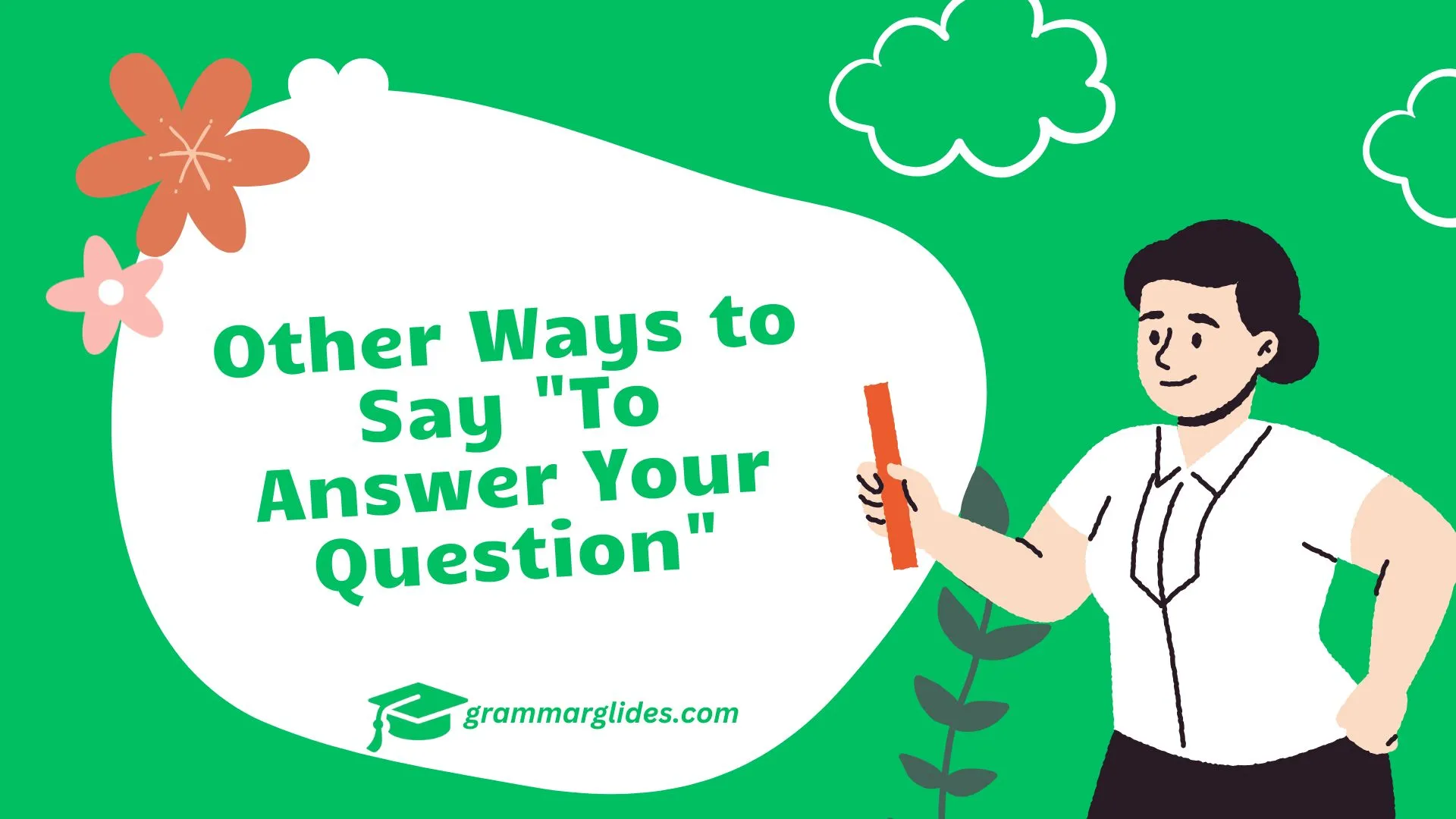“Clarity is key; let’s provide the insight you seek.”
When someone poses a question, how you respond can significantly impact the effectiveness of your communication. The phrase “To answer your question” is commonly used, but it can sometimes feel repetitive or formal. Finding fresh alternatives can make your responses feel more engaging and dynamic, enhancing your communication style.
Using varied expressions shows that you value the question and are keen to provide clear and helpful information. This not only keeps the conversation flowing but also fosters a more inviting atmosphere for dialogue. By opting for alternatives, you can make your responses feel more tailored and thoughtful.
In this post, we’ll explore 30 different ways to express the idea of “To answer your question.” Each alternative will come with a scenario, examples, and explanations to clarify their usage. Whether you’re in a meeting, writing an email, or having a casual conversation, these phrases will help you articulate your thoughts more effectively.
1. “In response to your inquiry”
Scenario: Formal email communication.
Example 1: “In response to your inquiry, I would like to clarify…”
Example 2: “In response to your inquiry about the project timeline…”
Explanation: This phrase is suitable for formal contexts, signaling that you are addressing the person’s specific question.
2. “Regarding your question”
Scenario: When discussing a specific topic.
Example 1: “Regarding your question about pricing…”
Example 2: “Regarding your question on the new policy…”
Explanation: This approach directly connects to the person’s query, ensuring clarity in your response.
3. “To clarify”
Scenario: Offering additional details.
Example 1: “To clarify, the deadline is next Friday.”
Example 2: “To clarify my previous point…”
Explanation: This phrase indicates that you are providing further explanation to avoid confusion.
4. “To provide some insight”
Scenario: Sharing expertise or knowledge.
Example 1: “To provide some insight, the study indicates…”
Example 2: “To provide some insight into the situation…”
Explanation: This phrase adds a more knowledgeable tone to your response, showing that you are informed.
5. “As for your question”

Scenario: Transitioning to the answer.
Example 1: “As for your question about the budget…”
Example 2: “As for your question on the event schedule…”
Explanation: This expression effectively shifts the conversation towards addressing the inquiry.
6. “To address your question”
Scenario: Directly addressing the query.
Example 1: “To address your question, we have…”
Example 2: “To address your question about our policies…”
Explanation: This phrase clearly indicates that you are focusing on the question at hand.
7. “In answer to your question”
Scenario: Providing a straightforward answer.
Example 1: “In answer to your question, yes, we can accommodate that.”
Example 2: “In answer to your question, the event starts at 3 PM.”
Explanation: A simple and direct way to answer, suitable for various contexts.
8. “To respond to your inquiry”
Scenario: Formal setting or documentation.
Example 1: “To respond to your inquiry, I have attached…”
Example 2: “To respond to your inquiry about the report…”
Explanation: This phrase maintains a formal tone while directly addressing the person’s question.
Other Ways to Say Valuable Learning Experience
9. “Let me explain”
Scenario: When elaborating on a complex topic.
Example 1: “Let me explain how this works…”
Example 2: “Let me explain the reasoning behind our decision…”
Explanation: This phrase invites the recipient to listen closely, suggesting that your answer requires more context.
10. “To shed light on your question”
Scenario: Providing clarity.
Example 1: “To shed light on your question, we consider…”
Example 2: “To shed light on your question about the procedure…”
Explanation: This phrase conveys that you are helping the person understand better.
11. “Let me clarify”

Scenario: Addressing potential confusion.
Example 1: “Let me clarify what I meant earlier…”
Example 2: “Let me clarify the steps involved…”
Explanation: This phrase is helpful when the original message may have been unclear.
12. “Here’s what I think”
Scenario: Offering a personal perspective.
Example 1: “Here’s what I think about your question…”
Example 2: “Here’s what I think will work best…”
Explanation: This phrase adds a personal touch to your response, making it feel less formal.
13. “To summarize my thoughts”
Scenario: Providing a concise answer.
Example 1: “To summarize my thoughts, we should proceed with the plan.”
Example 2: “To summarize my thoughts on the proposal…”
Explanation: This phrase helps distill your answer to its essentials, making it easier for the recipient to grasp.
14. “To respond directly”
Scenario: Addressing the question without fluff.
Example 1: “To respond directly, we will need more time.”
Example 2: “To respond directly to your question…”
Explanation: This approach emphasizes straightforwardness, which is appreciated in business communication.
15. “Here’s the answer”
Scenario: Casual conversation or informal email.
Example 1: “Here’s the answer you were looking for…”
Example 2: “Here’s the answer to your earlier question…”
Explanation: A friendly and approachable way to provide information, suitable for informal exchanges.
16. “What I can tell you is”
Scenario: Providing specific information.
Example 1: “What I can tell you is that we are on track.”
Example 2: “What I can tell you is based on our data…”
Explanation: This phrase sets the stage for your response and emphasizes the information you’re about to share.
17. “To further elaborate”
Scenario: Offering more details.
Example 1: “To further elaborate, we found that…”
Example 2: “To further elaborate on the topic…”
Explanation: This phrase indicates that you will provide additional information that enhances understanding.
18. “On that note”
Scenario: Transitioning to a related topic.
Example 1: “On that note, I believe we should consider…”
Example 2: “On that note, the next steps are…”
Explanation: This phrase connects the question to a broader discussion or point you want to make.
19. “With regard to your question”
Scenario: Formal response.
Example 1: “With regard to your question about our services…”
Example 2: “With regard to your question on deadlines…”
Explanation: A formal way to direct the conversation towards the topic of the question.
20. “In light of your question”
Scenario: Acknowledging the relevance of the inquiry.
Example 1: “In light of your question, we decided to…”
Example 2: “In light of your question about the results…”
Explanation: This phrase shows that you are considering the question seriously in your response.
21. “Thank you for your question”
Scenario: Acknowledging the question.
Example 1: “Thank you for your question; it’s an important topic.”
Example 2: “Thank you for your question; I appreciate your interest.”
Explanation: This expression demonstrates gratitude and reinforces a positive tone.
22. “As you requested”

Scenario: When the person asked for specific information.
Example 1: “As you requested, here are the details…”
Example 2: “As you requested, I have compiled the data…”
Explanation: This phrase acknowledges the person’s specific request, making your response more tailored.
23. “To touch on your question”
Scenario: Briefly addressing the topic.
Example 1: “To touch on your question, we are currently evaluating…”
Example 2: “To touch on your question about the deadline…”
Explanation: This phrase indicates that you will address the question but may not delve into extensive detail.
24. “To help clarify”

Scenario: Providing further explanation.
Example 1: “To help clarify the situation, let me explain…”
Example 2: “To help clarify my earlier statement…”
Explanation: This phrase signals that you’re about to provide more information to enhance understanding.
25. “As I mentioned earlier”
Scenario: Referring back to a previous point.
Example 1: “As I mentioned earlier, the report is due next week.”
Example 2: “As I mentioned earlier in our discussion…”
Explanation: This phrase reinforces points previously made, linking them to the current question.
26. “To break it down”
Scenario: Simplifying complex information.
Example 1: “To break it down, the steps are…”
Example 2: “To break it down further, we need to…”
Explanation: This phrase invites the recipient to listen closely for a simplified explanation.
27. “Let’s address that”
Scenario: Proactive response.
Example 1: “Let’s address that concern right now…”
Example 2: “Let’s address that question about the budget…”
Explanation: This phrase shows readiness to tackle the issue head-on.
28. “The answer lies in”
Scenario: Indicating where the information can be found.
Example 1: “The answer lies in our latest report…”
Example 2: “The answer lies in the data we collected…”
Explanation: This phrase guides the recipient to the source of information.
29. “To reiterate”
Scenario: Emphasizing a key point.
Example 1: “To reiterate, our main goal is…”
Example 2: “To reiterate the importance of your question…”
Explanation: This phrase emphasizes the significance of the question and the importance of the response.
30. “To sum up”

Scenario: Concluding the response.
Example 1: “To sum up, we will proceed as discussed.”
Example 2: “To sum up the answer to your question…”
Explanation: This phrase provides a succinct summary, ensuring the key points are clear.
Why is it beneficial to use varied phrases when responding to questions?
Using varied phrases enhances communication by keeping the conversation engaging and dynamic. It shows that you value the question and are invested in providing a thoughtful response. This approach can lead to better understanding and stronger relationships between the parties involved.
Conclusion
Exploring alternatives to “To answer your question” can significantly improve your communication skills. By using varied phrases, you can tailor your responses to suit different contexts, making your communication more effective and engaging.
Each alternative offers a unique way to acknowledge inquiries and provide valuable information, helping you connect better with your audience. Embracing these options not only clarifies your message but also demonstrates your professionalism and attentiveness to the needs of others.

Hi! I’m Jane Austen, the author of Grammar Glides. I make English learning simple and fun, helping you master grammar with ease!












